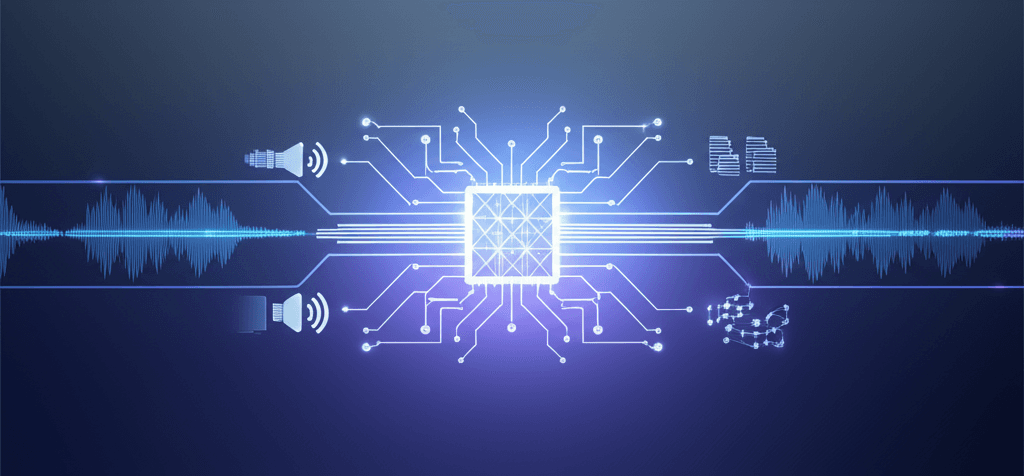ElevenLabs' Conversational AI 2.0 delivers truly natural, human-like AI interactions.
Overcoming AI's awkward pauses, this system blends speech and text for truly natural, intelligent, and context-aware conversations.
May 31, 2025

ElevenLabs has launched Conversational AI 2.0, an advanced AI voice system designed to facilitate more natural and seamless interactions by analyzing conversational cues in real-time and processing both speech and text inputs simultaneously.[1][2] This updated platform aims to overcome common hurdles in human-AI dialogue, such as awkward pauses and unnatural interruptions, by incorporating a sophisticated turn-taking model.[3][2] The system can understand when to speak, when to listen, and even when to interrupt, leading to a more fluid and human-like conversational experience.[2] This development signifies a notable step forward in making AI interactions feel less robotic and more intuitive.[4][5][2]
A core component of ElevenLabs' new system is its ability to handle multimodality, meaning it can process and respond to both spoken words and typed text within the same interaction.[1][2] This allows users to switch between input methods seamlessly, choosing the most convenient or precise option for the information they need to convey.[1] For instance, a user might verbally ask a question and then type out a complex name or address. The AI agent can understand and integrate both inputs, leading to increased accuracy and a more flexible user experience.[1] This feature is particularly beneficial for tasks involving sensitive or complex data entry where precision is paramount.[1] Furthermore, the system supports integrated automatic language detection, enabling the AI to identify the language being spoken and respond appropriately without manual switching, facilitating "seamless multilingual discussions".[3][6][2]
Another significant enhancement in Conversational AI 2.0 is the integration of Retrieval-Augmented Generation (RAG).[3][6][2] This allows the AI agents to access and incorporate information from external knowledge bases in real-time, providing more knowledgeable and contextually relevant responses.[3][6] ElevenLabs has integrated this RAG capability directly into the voice agent architecture, aiming for minimal latency and maximum privacy.[3][6][2] This means AI agents can be equipped with specific domain knowledge, making them suitable for a wider range of applications, from customer service to educational tools.[7][8] The platform offers a composable and customizable set of tools, allowing developers to build voice agents tailored to specific business or personal needs, integrating with leading large language models (LLMs) such as those from Google, OpenAI, and Anthropic, or even allowing users to bring their own models.[7]
The implications of such advancements in conversational AI are far-reaching for various industries. In customer service, these more intelligent and natural-sounding voice agents can handle a greater volume of inquiries with improved efficiency and customer satisfaction.[9][10][11][8] The ability to understand nuances in conversation and access specific knowledge bases allows for more effective troubleshooting and support.[7][12] In healthcare, AI agents with HIPAA compliance can assist with patient interactions, appointment scheduling, and providing health information.[7][3][6] Educational applications include intelligent tutors that can adapt to individual learning styles and provide personalized feedback.[7][8] The system's low-latency performance is crucial in these applications, as delays can lead to user frustration and break the conversational flow.[4][13][14][15] Research indicates that people start to detect lag around 100 to 120 milliseconds, and anything beyond a quarter of a second can make a response feel slow or robotic.[4] ElevenLabs emphasizes its low-latency text-to-speech technology and the ability to manage pauses and interruptions effectively.[7][16][17] The company's Turbo 2.5 model, for example, reportedly triples the processing speed for numerous languages, aiming for high-quality, low-latency conversational AI for a significant portion of the global population.[18]
Despite these advancements, challenges in conversational AI development remain. Ensuring data privacy and security is paramount, especially when AI agents handle sensitive information.[9][19][20][21] ElevenLabs addresses this with enterprise-grade security, optional EU data residency, and features like secret dynamic variables that are never sent to an LLM.[3][22][6] Another challenge is overcoming biases in training data, which can lead to unfair or inaccurate AI responses.[19][23] Maintaining context over long conversations and handling ambiguous language are ongoing areas of development for all conversational AI systems.[19][23][24][12] User trust and acceptance also play a critical role; transparency about AI capabilities and limitations is key to building this trust.[19][25] ElevenLabs provides tools for developers, including server-side and client-side tools, monitoring dashboards, and dynamic agent creation, to help refine and deploy these AI agents effectively.[7] The platform also includes an AI speech classifier to detect if audio was generated by ElevenLabs, promoting responsible use of the technology.[26]
In conclusion, ElevenLabs' Conversational AI 2.0 represents a significant stride towards more human-like and efficient AI voice interactions. By enabling simultaneous speech and text processing, integrating advanced knowledge retrieval, and focusing on low-latency, natural-sounding responses, the system opens up new possibilities for businesses and developers.[1][6][2][27] While challenges in the broader field of conversational AI persist, such as data privacy, bias mitigation, and maintaining long-term contextual understanding, the continuous improvements in platforms like ElevenLabs are pushing the boundaries of what's possible in human-AI communication.[9][19][23][20][21][24][12] The focus on enterprise readiness, including features like HIPAA compliance and robust security, indicates a maturation of the technology and its potential for wider adoption across various sectors.[3][6]
Sources
[2]
[4]
[9]
[10]
[11]
[12]
[13]
[14]
[15]
[16]
[17]
[18]
[19]
[20]
[21]
[22]
[23]
[24]
[25]
[26]
[27]